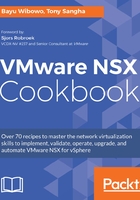
To get the most out of this book
The book was written using vSphere version 6.5 and NSX-v version 6.3. vSphere 5.5 and later can be used, but you should independently validate all software components are compatible with the version of NSX you are deploying via the VMware Product Interoperability Matrices (https://www.vmware.com/resources/compatibility/sim/interop_matrix.php), and all hardware should be checked via the VMware Hardware Compatibility Guide (HCL) (http://www.vmware.com/go/hcl).
To install VMware for vSphere you will need to obtain the appropriate software; unfortunately, without a valid contract you will need contact the VMware sales team (http://www.vmware.com/company/contact_sales.html) to obtain it.
All recipes require a supported guest operating system, web browser, and Adobe Flash Player to access the vSphere Web Client. The minimum supported requirements are vSphere version-dependent; for example, the requirements for vSphere 6.5 are documented at the following URL: https://docs.vmware.com/en/VMware-vSphere/6.5/com.vmware.vsphere.install.doc/GUID-F6D456D7-C559-439D-8F34-4FCF533B7B42.html. Additionally, you will need an SSH client to access ESXi hosts and/or NSX components.
Two of the recipes in Chapter 4, Configuring VMware NSX Layer 2 Bridging, are based on hardware VTEP bridging, which requires compatible hardware. Unless you have a compatible piece of hardware, you may not be able to test this recipe. In this case, you can visit an online interactive simulation provided by VMware Hands-on Labs to walk through configuration steps in detail: http://docs.hol.vmware.com/hol-isim/HOL-2017/hol-1703-arista.htm.
The NSX Identity Firewall in Chapter 6, Configuring VMware NSX Distributed Firewall (DFW) and SpoofGuard, and Endpoint Monitoring in Chapter 11, Managing and Monitoring VMware NSX Platform, require a compatible desktop operating system. The specific list of compatible operating systems are covered in the respective chapters, and at the time of writing this book, was limited to Microsoft Windows operating systems only.
Chapter 7, Configuring Cross-vCenter NSX, is a multi-vCenter setup that requires additional compute infrastructure and virtual components for complete configuration. This includes a minimum of two vCenter servers, two NSX managers, and the relevant infrastructure components for each.
Chapter 8, Backing up and Restoring VMware NSX Components, covers backup and software of NSX components and requires deployment of either a File Transfer Protocol (FTP) or SSH File Transfer Protocol (SFTP) server.
VMware vRealize Log Insight (vRLI) is covered in Chapter 11, Managing and Monitoring VMware NSX Platform; deployment and configuration for vRLI is not within the scope of this book. However, VMware NSX customers are entitled for VMware vRealize Log Insight, see VMware KB 2145800 vRealize Log Insight for NSX FAQ https://kb.vmware.com/s/article/2145800.
Chapter 12, Leveraging the VMware NSX REST API for Management and Automation, covers the NSX REST API and requires the following software installed on your administrative machine for testing:
- Postman: https://www.getpostman.com/
- Windows PowerShell or PowerShell Core: https://microsoft.com/powershell
- Python 2.7 or Python 3: https://www.python.org/downloads/
- vRealize Orchestrator: https://www.vmware.com/products/vrealize-orchestrator.html
- NSX-vRO plugin
If you do not have an environment to work with NSX, you can still test-drive NSX on VMware Hands-on Lab (HOL): https://www.vmware.com/products/nsx/nsx-hol.html.